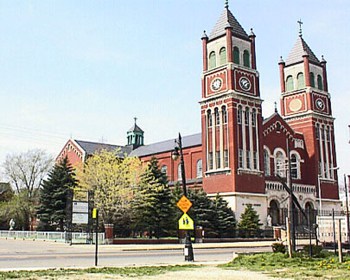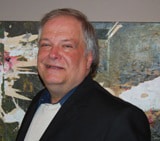

Saint Maximilian Kolbe the Conventional Franciscan priest who was a hero and martyr at Auschwitz-Birkenau had a connection with Fr. Hippolite Kuras along with Walter Kuras and Stanley Kuras who were both American GI’s and POW’s interred in sub-camps.
Joseph Kuras of Detroit was Fr. Hippolite’s Godfather when he was baptized at St. Hedwig’s in 1906. The future priest went to St. Hedwig’s grade school on Junction Avenue under the Felician Nuns and later became a Conventional Franciscan after seminary in Poland. Another cousin Vince Kuras said, “As patriarch, I declare we have part of Malopolska in this little section of Detroit.
The author personally remembers stories of Busia (Grandmother) sending care packages to Poland to help the displaced persons.
Kolbe was the Latin Professor for Fr. Hippolite at the Franciscan Seminary in Krakow. Saint Maximilian Kolbe was canonized on October 10, 1982, and was highlighted by Pope John Paul II, “I declare him the Patron Saint of Our Difficult Century, he….. (Kolbe)….my martyr of charity.” Kolbe was known to have saved 2,000 Jews at his Friary in Niepokalanow, Poland by hiding them from the Nazis.
The Reverend Kuras told me many Polonia stories including taking care of his family near the end of 1918 during the influenza epidemic in the United States. “I was only 12 but school was closed because so many were dying. The funerals were day and night on Konkel Street,” said the priest. “When I was in seminary in Krakow, I was Kolbe’s best zaawansowany student, he was very demanding.”
Another Kuras relation in Poland, Jozef Kuras, was the partisan commander in the Zakopane region and headed up the Ogrien Brigade (Fire Brigade). He was summoned to Krakow to meet with Jan Karski (aka- Jan Kanicki and Jan Kozielewski). Karski’s older brother was a Polish police chief in the Krakow area. It was they who planned Karski’s escape to tell Churchill and Roosevelt about the horrors in the Warsaw Ghetto. Karski was eventually able to tell both Churchill and Roosevelt in person about the death factories and extermination centers.
Leon Feiner and Menachem Kirschenbaum both Jewish underground leaders met with Karski. Karski, who had perfect retention of his meetings with the Polish-Jewish Patriots, recalled the conversations. Kirschenbaum had said, “Nobody could ever understand the horrors that had befallen the Jews.” He was crying. Feiner calmed Kirschenbaum and said to Karski, “You Poles are also suffering. But after the war, Poland will be restored. Your wounds will slowly heal. By then, however, Polish Jewry will no longer exist. Hitler will lose this war, but he will win the war he has declared against the Polish Jews. You must get out our message.” (From “Karski: How One Man Tried to Stop the Holocaust”, John Wiley and Sons, Publishers)
Feiner went on to tell Karski, “But we know England, we know the West. What you are going to tell them is unprecedented. They may have doubts. It would help us if you could say that you saw it with your own eyes. We could smuggle you into the ghetto in Warsaw. There would be no danger whatsoever to you. I will be your guide. And we could try to smuggle you into the Belzec camp. This is dangerous but we wouldn’t expose you to certain death. Will you go?”
After touring the Warsaw Ghetto, he donned a disguise to enter a Nazi concentration camp in Eastern Poland. There he witnessed mass murder. The World Jewish Congress supplied the money to bribe a Ukrainian guard so as to use his uniform during the masquerade. After Karski visited the Warsaw Ghetto he went back to the Krakow area and Kuras got him out of Poland into Czechoslovakia and then into France.
Aleksander Kawalkowski was the leader of the Polish underground in France who helped coordinate Karski’s hazardous passage through that occupied zone.
Auschwitz, located in Oswięcim, Poland near Krakow, has become a symbol of the Holocaust. One of the main reasons that Nazi Germany established the camp there was because it was a central intersection of roads and railways. Before WW II, Jews living in Oswięcim, who were often artisans or merchants, constituted approximately half of this small town’s population. After the Holocaust, Oswięcim will forever be overshadowed by Auschwitz-Birkenau, the largest of the Nazi concentration camps and extermination centers.
Not only has Auschwitz become a symbol of the Holocaust due to its geographical size and so many sub-camps, but also because Jews were sent there from all over Europe to undergo the systematic murder in the gas chambers. In perpetuity, we now have many detailed testimonies of Holocaust victims who survived the camps.
It was in 1942 that Karski reported to the Polish, British and U.S. governments on the situation in Poland. Especially cited was the destruction of the Warsaw Ghetto and the Holocaust of the Jews. He had also carried from Poland a microfilm with further information from the underground movement on the extermination of European Jews in German occupied Poland.
Karski had been captured and tortured twice by the Gestapo but managed to escape and eventually bear witness of Nazi atrocities.
Holocaust survivor and author Elie Wiesel said of Karski, “He was a man of absolute integrity, of extraordinary force of character. I had a feeling from the moment I saw him that he carried secret invisible wounds in him…….I saw he was fighting back the memories. These were perilous times.”
Again, “Let us never forget.”

Editors Note: Raymond Rolak is a well traveled historian and sports broadcaster.
At the Holocaust Memorial Center– May 1, 2011
28123 Orchard Lake Road Farmington Hills, Michigan
The annual community-wide Yom HaShoah Commemoration will be held on Sunday, May 1, 2011, at 1:00 p.m.
We will also celebrate the 30th anniversary of C.H.A.I.M.
Following the Yom HaShoah service we shall dedicate a new permanent electronic exhibit Portraits of Honor: Michigan’s Holocaust Survivors
This Yom HaShoah Commemoration is made possible with the cooperation of:
The Shaarit Haplaytah Organization of Metro Detroit
C.H.A.I.M. – Children of Holocaust-Survivors Association in Michigan
Hidden Children and Child Survivors of Michigan
Jewish Senior Life of Metropolitan Detroit
Admission to the HMC will be waived for the day’s events & complimentary valet parking will be available
For further information, contact Selma Silverman at 248.553.2400, ext. 12
